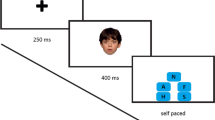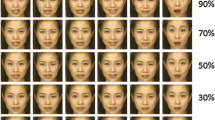Abstract
Children with Duchenne or Becker muscular dystrophy (MD) have delayed language and poor social skills and some meet criteria for Pervasive Developmental Disorder, yet they are identified by molecular, rather than behavioral, characteristics. To determine whether comprehension of facial affect is compromised in boys with MD, children were given a matching-to-sample test with four types of visual recognition (Object, Face, Affect, and Situation matching) developed by Lucci and Fein. Within-group analyses on 50 boys with MD found decreased Affect matching relative to the other matching conditions. Between-group comparisons on 20 sibling pairs found the boys with Duchenne performed more poorly only on the Affect-matching condition. Thus, mildly impaired facial affect recognition may be part of the phenotype associated with Duchenne or Becker MD.
Similar content being viewed by others
References
Achenbach, T.M. (1991). Manual for the child behavior checklist/4-18 and 1991 Profile. Burlington, VT: University of Vermont, Department of Psychiatry.
American Psychiatric Association (1994). Diagnostic and statistical manual of mental disorders (4th ed.). Washington, DC: American Psychiatric Association.
Anderson, J.L., Head, S.I., Rae, C., & Morley, J.W. (2002). Brain function in Duchenne muscular dystrophy. Brain, 125, 4–13.
Billard, C., Gillet, P., Barthez, M.-A., Hommet, C., & Bertrand, P. (1998). Reading ability and processing in Duchenne muscular dystrophy and spinal muscular atrophy. Developmental Medicine and Child Neurology, 40, 12–20.
Billard, C., Gillet, P., Signoret, J.L., Uicaut, E., Bertrand, P., Fardeau, M., Barthez-Carpentier, M.A., & Santini, J.J. (1992). Cognitive functions in Duchenne muscular dystrophy: A reappraisal and comparison with spinal muscular atrophy. Neuromuscular Disorders, 2, 371–378.
Bolte, S., & Poustka, F. (2003). The recognition of facial affect in autistic and schizophrenic subjects and their first-degree relatives. Psychological Medicine, 33(5), 907–915.
Braverman, M., Fein, D., Lucci, D., & Waterhouse, L. (1989). Affect comprehension in children with pervasive developmental disorders. Journal of Autism and Developmental Disorders, 19(2), 301–316.
Bushby, K.M., Appleton, R., Anderson, L.V., Welch, J.L., Kelly, P., & Gardner-Medwin, D. (1995). Deletion status and intellectual impairment in Duchenne muscular dystrophy. Developmental Medicine and Child Neurology, 37(3), 260–269.
Cotton, S., Voudouris, N.J., & Greenwood, K.M. (2001). Intelligence and Duchenne muscular dystrophy: Full-scale, verbal, and performance intelligence quotients. Developmental Medicine and Child Neurology, 43, 497–501.
Critchley, H.D., Daly, E.M., Bullmore, E.T., Williams, S.C., Van Amelsvoort, T., Robertson, D.M., Rowe, A., Phillips, M., McAlonan, G., Howlin, P., & Murphy, D.G. (2000). The functional neuroanatomy of social behaviour: Changes in cerebral blood flow when people with autistic disorder process facial expressions. Brain, 123(Pt 11), 2203–2212.
Cyrulnik, S., Fee, R., Kiefel, J., & Hinton, V.J. (2004). Preschool children with Duchenne muscular dystrophy exhibit deficits in communication skills and social skills that are characteristic of Pervasive Developmental Disorder. Proceeding of the 33rd International Neuropsychology Society Annual Meeting, Baltimore, MD, p. 48.
Darke, J., Bushby, K., Couteur, A.L, & McConachie, H. (2006). Survey of behaviour problems in children with neuromuscular diseases. European Journal of Paediatric Neurology, 10(3), 129–134.
Darwin, C. (1872). The expression of emotions in man and animals. London: Albermarle.
Dorman, C., Hurley, A.D., & D’Avignon, J. (1988). Language and learning disorders of older boys with Duchenne muscular dystrophy. Developmental Medicine and Child Neurology, 30, 316–327.
Dunn, L.M., & Dunn, L.M. (1997). Examiner’s manual for the PPVT-III peabody picture vocabulary test third edition (3rd ed.). Circle Pines, MN: American Guidance Service.
Dykens, E.M., & Hodapp, R.M. (2001). Research in mental retardation: Toward an etiologic approach. Journal of Child Psychology and Psychiatry, 42, 49–71.
Ekman, P. (1994). Strong evidence for universals in facial expressions: A reply to Russell’s mistaken critique. Psychological Bulletin, 115, 268–287.
Ekman, P., & Friesen, W.V. (1971). Constants across cultures in the face and emotion. Journal of Personality and Social Psychology, 29, 288–298.
Ekman, P., Friesen, W.V., & Ellsworth, P. (1972). Emotion in the human face: Guidelines for research and an integration of findings. New York: Pergamon.
Fein, D., Lucci, D., Braverman, M., & Waterhouse, L. (1992). Comprehension of affect in context in children with pervasive developmental disorders. Journal of Child Psychology and Psychiatry and Allied Disciplines, 33(7), 1157–1167.
Felisari, G., Martinelli Boneschi, F., Bardoni, A., Sironi, M., Comi, G.P., Robotti, M., Turconi, A.C., Lai, M., Corrao, G., & Bresolin N. (2000). Loss of Dp140 dystrophin isoform and intellectual impairment in Duchenne dystrophy. Neurology, 55(4), 559–564.
Gross, T.F. (2004). The Perception of four basic emotions in human and nonhuman faces by children with autism and other developmental disabilities. Journal of Child Psychology and Psychiatry and Allied Disciplines, 32(5), 469–480.
Haxby, J.V., Hoffman, E.A., & Gobbini, M.I. (2002). Human neural systems for face recognition and social communication. Biological Psychiatry, 51(1), 59–67.
Herba, C., & Phillips, M. (2004). Annotation: Development of facial expression recognition from childhood to adolescence: Behavioural and neurological perspectives. Journal of Child Psychology and Psychiatry and Allied Disciplines, 45(7), 1185–1198.
Hinton, V.J., De Vivo, D.C., Fee, R., Goldstein, E., & Stern, Y. (2004). Investigation of poor academic achievement in children with Duchenne muscular dystrophy. Learning Disabilities Research and Practice, 19, 146–154.
Hinton, V.J., De Vivo, D.C., Nereo, N.E., Goldstein, E., & Stern, Y. (2000). Poor verbal working memory across intellectual level in boys with Duchenne dystrophy. Neurology, 54, 2127–2132.
Hinton, V.J., De Vivo, D.C., Nereo, N.E., Goldstein, E., & Stern, Y. (2001). Selective deficits in verbal working memory associated with a known genetic etiology: The neuropsychological profile of Duchenne muscular dystrophy. Journal of the International Neuropsychological Society, 7, 45–54.
Hinton, V.J., Nereo, N.E., Fee, R., & Cyrulnik S. (in press). Social behavior problems in boys with Duchenne muscular dystrophy. Journal of Developmental and Behavioral Pediatrics.
Hobson, P.R. (1986a). The autistic child’s appraisal of expressions of emotion. Journal of Child Psychology and Psychiatry and Allied Disciplines, 27, 321–342.
Hobson, P.R. (1986b). The autistic child’s appraisal of expressions of emotion; a further study. Journal of Child Psychology and Psychiatry and Allied Disciplines, 27, 671–680.
Kaplan, L.C., Osborne, P., & Elias, E. (1986). The diagnosis of muscular dystrophy in patients referred for language delay. Journal of Child Psychology and Psychiatry and Allied Disciplines, 27, 545–549.
Klin, A., Sparrow, S.S., de Bildt, A., Cicchetti, D.V., Cohen, D.J., & Volkmar, F.R. (1999) A normed study of face recognition in autism and related disorders. Journal of Autism and Developmental Disorders, 29(6), 499–508.
Koenig, M., Hoffman, E.P., Bertelson, C.J., Monaco, A.P., Feener, C., & Kunkel, L.M. (1987). Complete cloning of the Duchenne muscular dystrophy (MD) cDNA and preliminary genomic organization of the MD gene in normal and affected individuals. Cell, 50, 509–517.
Komoto, J., Usui, S., Otsuki, S., & Terao, A. (1984). Infantile autism and Duchenne muscular dystrophy. Journal of Autism and Developmental Disorders, 14(2), 191–195.
Lee, J.S., Pfund, Z., Juhasz, C., Behen, M.E., Muzik, O., Chugani, D.C., Nigro, M.A., & Chugani, H.T. (2002). Altered regional brain glucose metabolism in Duchenne muscular dystrophy: a pet study. Muscle Nerve, 26(4), 506–512.
Mehler, M.F. (2000). Brain dystrophin, neurogenetics and mental retardation. Brain Research Reviews, 32, 277–307.
Moizard, M.P., Billard, C., Toutain, A., Berret, F., Marmin, N., & Moraine, C. (1998). Are Dp71 and Dp140 brain dystrophin isoforms related to cognitive impairment in Duchenne muscular dystrophy? American Journal of Medical Genetics, 80(1), 32–41.
Nelson, C.A. (1987). The recognition of facial expressions in the first two years of life: Mechanisms of development. Child Development, 58(4), 889–909.
Ogasawara, A. (1989). Downward shift in IQ in persons with Duchenne muscular dystrophy compared to those with spinal muscular atrophy. American Journal of Mental Retardation, 93, 544–547.
Ozonoff, S., Pennington, B.F., & Rogers, S.J. (1990). Are there emotion perception deficits in young autistic children? Journal of Child Psychology and Psychiatry and Allied Disciplines, 31(3), 343–361.
Pierce, K., Haist, F., Sedaghat, F., & Courchesne, E. (2004). The brain response to personally familiar faces in autism: Findings of fusiform activity and beyond. Brain, 127(Pt 12), 2703–2716.
Raven, J.C., Court, J.H., & Raven, J. (1990). Coloured Progressive Matrices. Oxford, UK: Oxford Psychologists Press.
Smith, R.A., Sibert, J.R., & Harper, P.S. (1990). Early development of boys with Duchenne muscular dystrophy. Developmental Medicine and Child Neurology, 32, 519–527.
Tanturn, D., Monaghan, L., Nicholson, H., & Stirling, J. (1989). Autistic children’s ability to interpret faces: A research note. Journal of Child Psychology and Psychiatry, 39, 623–630.
Wang, A.T., Dapretto, M., Hariri, A.R., Sigman, M., & Bookheimer, S.Y. (2004). Neural correlates of facial affect processing in children and adolescents with autism spectrum disorder. Journal of the American Academy of Child and Adolescent Psychiatry, 43(4), 481–490.
Whelan, T.B. (1987). Neuropsychological performance of children with Duchenne muscular dystrophy and spinal muscular atrophy. Developmental Medicine and Child Neurology, 29, 212–220.
Wu, J.Y., Kuban, K.C., Allred, E., Shapiro, F., & Darras, B.T. (2005). Association of Duchenne muscular dystrophy with autism spectrum disorder. Journal of Child Neurology, 20(10), 790–795.
Zwaigenbaum, L., & Tarnopolsky, M. (2003). Two children with muscular dystrophies ascertained due to referral for diagnosis of autism. Journal of Autism and Developmental Disorders, 33(2), 193–199.
Acknowledgments
We are most indebted to Dorothy Lucci and Deborah Fein and colleagues for generously developing and sharing their Object, Face, Affect, and Situation measure. We thank Elizabeth Flamm for her helpful contributions to the error analysis. We are extremely grateful to all the families who graciously gave their time to participate in this study. This work was supported by grants from NICHD (R29 NS34155), NINDS (R01 NS047918-06A2) and the Muscular Dystrophy Association.
Author information
Authors and Affiliations
Corresponding author
Rights and permissions
About this article
Cite this article
Hinton, V.J., Fee, R.J., De Vivo, D.C. et al. Poor Facial Affect Recognition Among Boys with Duchenne Muscular Dystrophy. J Autism Dev Disord 37, 1925–1933 (2007). https://doi.org/10.1007/s10803-006-0325-5
Received:
Accepted:
Published:
Issue Date:
DOI: https://doi.org/10.1007/s10803-006-0325-5




